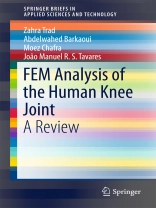In recent years, numerous scientific investigations have studied the anatomical, biomechanical and functional role of structures involved in the human knee joint. The Finite Element Method (FEM) has been seen as an interesting tool to study and simulate biosystems. It has been extensively used to analyse the knee joint and various types of knee diseases and rehabilitation procedures such as the High Tibial Osteotomy (HTO). This work presents a review on FEM analysis of the human knee joint and HTO knee surgery, and discusses how adequate this computational tool is for this type of biomedical applications. Hence, various studies addressing the knee joint based on Finite Element Analysis (FEA) are reviewed, and an overview of clinical and biomechanical studies on the optimization of the correction angle of the postoperative knee surgery is provided.
Daftar Isi
Introduction.- 1. Finite element models of the knee joint.- 1.1 Knee joint models geometries.- 1.2 Material properties of hard and soft tissues.- 1.2.1 Material properties of articular cartilage.- 1.2.2 Material properties of menisci.- 1.2.3 Material properties of ligaments.- 1.2.4 Material properties of bony structure.- 2. Finite Element Analysis applications in knee joint biomechanical studies.- 2.1 Current FEA applications on ligament injury.- 2.2 Current FEA applications on meniscus injury.- 2.3 Current FEA applications on knee joint contact analysis and cartilage disease.- 3. Overview of high tibial osteotomy and optimization of correction angle.- 3.1 High tibial osteotomy definition.- 3.2 Current FEA studies on HTO procedure.- 3.3 Current clinical studies on optimizing correction angle.- 3.4 Current biomechanical studies on optimizing correction angle.- 4. Conclusions and future work.- References.












